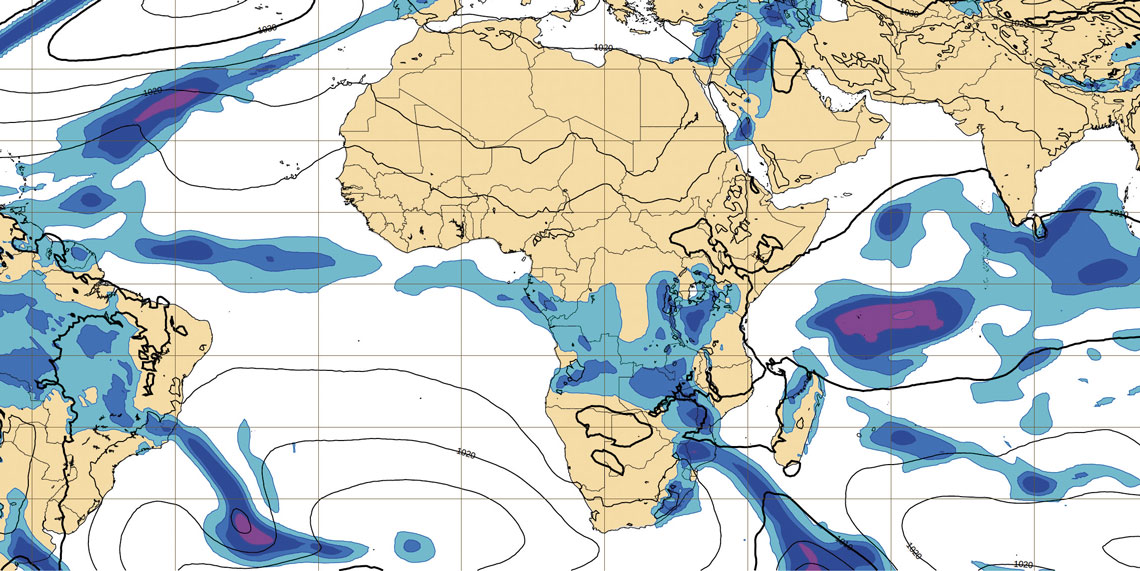On television, the weather forecast is announced within a matter of minutes, and on cell phones it can be read in seconds. The projections themselves, however, take hours to be made by supercomputers that use thousands of chips and consume vast amounts of electricity. Now, Google’s artificial intelligence (AI) laboratory DeepMind has developed a new model based on machine learning that can speed up the task and provide an accurate weather forecast for the entire globe in less than a minute.
According to an article published in the journal Science in November, the accuracy of 10-day weather forecasts provided by DeepMind’s GraphCast is, in most cases, superior to the best weather services currently available.
The study compared GraphCast’s performance with the HRES model, used by the world-renowned European Centre for Medium-Range Weather Forecasts (ECMWF). Google’s system made predictions for 1,380 climate variables, outperforming HRES more than 90% of the time. According to the article, GraphCast also performed better in 99% of cases when pitted against Pangu-Weather, another machine learning–based weather model recently developed by Chinese company Huawei.
“Our analyses revealed that GraphCast can also identify severe weather events earlier than traditional forecasting models, despite not having been trained to look for them,” said Google DeepMind’s Rémi Lam, lead author of the study.
The new weather forecasting system runs on the cloud, using machines fitted with a chip developed by Google specifically for tasks involving AI: the TPU v4. Unlike HRES and other traditional services, which use a deterministic model called numerical weather prediction, GraphCast uses AI to make its projections.
The former involves using complex mathematical equations based on atmospheric physics to predict whether it will be rainy or sunny that week, for example. The latter, meanwhile, uses a specific type of machine learning known as a graph neural network. This approach is useful for correlated spatially distributed data—the system effectively covers Earth’s atmosphere in a rectangular mesh of interconnected nodes and edges.
In machine learning, an algorithm analyzes past information to identify patterns and learn to make predictions. GraphCast was trained from an ECMWF database, which contains historical statistics about Earth’s atmosphere, oceans, and surface. Weather information from 1979 to 2017 was used to teach the Google model how to make predictions.

GraphCast
GraphCast shows rainfall forecasts for AfricaGraphCastThe AI model only requires two initial parameters: the current weather, and the weather conditions from around the world six hours earlier. It then predicts the weather for the next six hours. Based on this initial forecast, successive new projections are made for the following six-hour periods until a total of 10 days is completed.
The minimum area of the globe for which GraphCast can make a specific forecast is equivalent to a 28×28 kilometer (km) square. The HRES system provides 10-day projections for an area of land less than half that size. The Science article highlights that GraphCast outperforms HRES despite having a lower spatial resolution.
In the situations studied, the Google model was more efficient at predicting the weather almost 100% of the time. “We also carried out a test by adding meteorological data for two more recent years and saw that the closer to the current date, the better quality the forecasts are,” says Brazilian mathematician Meire Fortunato from Google DeepMind, one of the authors of the article.
“It is possible to train the model so that it can quickly adapt to recent weather conditions. The current architecture has not yet incorporated this functionality, but it is not a far-off advance,” says Fortunato. A possible bias in the AI forecast, recognizes the Brazilian, is that the model may work better in locations where more atmospheric data is available.
Luiz Augusto Machado, a meteorologist from the University of São Paulo (USP) who did not participate in the study, believes GraphCast’s biggest advantage is its low cost. While HRES requires a huge amount of computing power, GraphCast can generate forecasts with a cheap cloud service. One TPU v4 chip costs about US$5 per hour. “I believe GraphCast can provide better predictions for a forecast of 7–10 days ahead, when the quality of the deterministic model starts to decline,” says Machado.
The article also suggests that GraphCast was more accurate than the European system when inferring variables related to seasonal heat waves or cold fronts. The USP meteorologist has reservations, however, about this suggestion and the model’s ability to predict sudden changes, such as the occurrence of intense rain. “Due to climate change, the climatological norm is changing,” explains Machado. “If AI is trained on data from the past, I think it would have difficulty predicting these changes.”
For Rafael Santos, a computer scientist from the Brazilian National Institute for Space Research (INPE), Google DeepMind’s proposal is interesting, but has limitations. Although the system’s code is open to use by any person or organization, GraphCast can only run on cloud computing and the company’s proprietary hardware architecture. “This is a characteristic of Google’s business model. GraphCast is not exactly reproducible on INPE’s supercomputer,” points out Santos.
The Google DeepMind team sees the technology as a complementary tool to the deterministic model. Experimental weather forecasts by several AI-based meteorological models are available on the ECMWF website, including GraphCast, Pangu-Weather, and the European center’s own AI system, AIFS. Machado highlights an important detail: all the most renowned major meteorological centers are located in the Northern Hemisphere, where the equations that feed their models were developed. “Weather forecasting in tropical regions is of lower quality than in northern locations. Brazil should focus on remedying this issue,” recommends the USP meteorologist.
Scientific article
LAM, R. et al. Learning skillful medium-range global weather forecasting. Science. Vol. 382, no. 6677. Nov. 14, 23.
